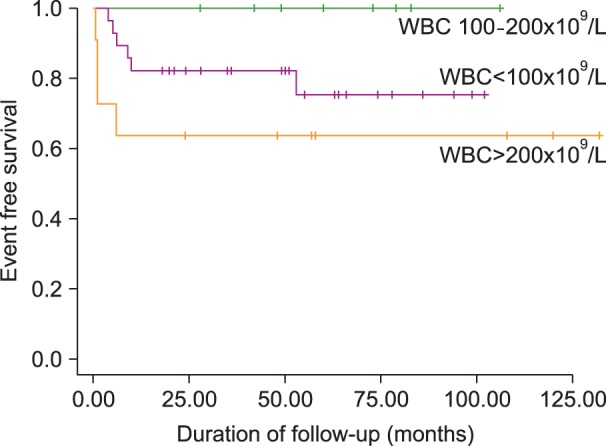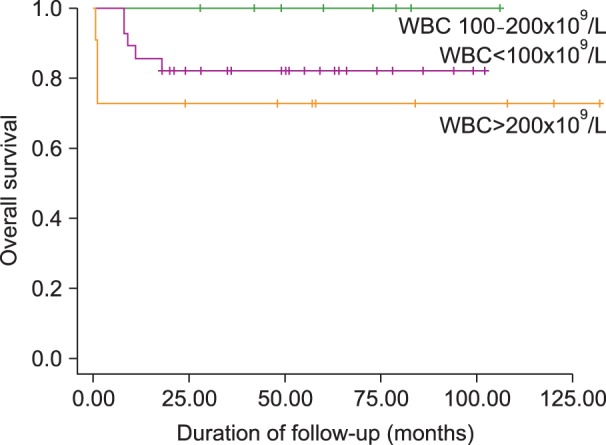Blood Res.
2014 Mar;49(1):29-35. 10.5045/br.2014.49.1.29.
Childhood acute lymphoblastic leukemia with hyperleukocytosis at presentation
- Affiliations
-
- 1Department of Pediatrics, Pusan National University College of Medicine, Busan, Korea. limyt@pusan.ac.kr
- KMID: 2172820
- DOI: http://doi.org/10.5045/br.2014.49.1.29
Abstract
- BACKGROUND
Hyperleukocytosis caused by acute lymphoblastic leukemia (ALL) is associated with early morbidity and mortality due to hyperviscosity arising from the excessive number of leukocytes.This study was designed to assess the incidence of hyperleukocytosis, survival outcomes, and adverse features among pediatric ALL patients with hyperleukocytosis.
METHODS
Between January 2001 and December 2010, 104 children with previously untreated ALL were enrolled at the Pusan National University Hospital. All of them were initially stratified based on the National Cancer Institute (NCI) risk; 48 (46.2%) were diagnosed with high-risk ALL. The medical charts of these patients were retrospectively reviewed.
RESULTS
Twenty (19.2%) of the 104 children with ALL had initial leukocyte counts of >100x10(9)/L, and 11 patients had a leukocyte count of >200x10(9)/L. Male gender, T-cell phenotype, and massive splenomegaly were positively associated with hyperleukocytosis. Common early complications during induction therapy included renal dysfunction, and central nervous system hemorrhage. The complete remission (CR) rate for the pediatric ALL patients with hyperleukocytosis (94.1%) was similar to the overall CR rate (95.6%). The estimated 3-year event free survival (EFS) and overall survival of ALL children with hyperleukocytosis were 75.0% and 81.2%, respectively. However, patients with initial leukocyte counts >200x10(9)/L had a lower EFS than those with initial leukocyte counts 100-200x109/L (63.6% vs. 100%; P=0.046).
CONCLUSION
The outcome of pediatric ALL cases with an initial leukocyte count >200x10(9)/L was very poor, probably due to early toxicity-related death during induction therapy.
Keyword
MeSH Terms
Figure
Reference
-
1. Wald BR, Heisel MA, Ortega JA. Frequency of early death in children with acute leukemia presenting with hyperleukocytosis. Cancer. 1982; 50:150–153. PMID: 7083119.
Article2. Harousseau JL, Tobelem G, Schaison G, et al. High risk acute lymphocytic leukemia: a study of 141 cases with initial white blood cell counts over 100,000/cu mm. Cancer. 1980; 46:1996–2003. PMID: 6932999.
Article3. Eguiguren JM, Schell MJ, Crist WM, Kunkel K, Rivera GK. Complications and outcome in childhood acute lymphoblastic leukemia with hyperleukocytosis. Blood. 1992; 79:871–875. PMID: 1737097.
Article4. Maurer HS, Steinherz PG, Gaynon PS, et al. The effect of initial management of hyperleukocytosis on early complications and outcome of children with acute lymphoblastic leukemia. J Clin Oncol. 1988; 6:1425–1432. PMID: 3166486.
Article5. Lowe EJ, Pui CH, Hancock ML, Geiger TL, Khan RB, Sandlund JT. Early complications in children with acute lymphoblastic leukemia presenting with hyperleukocytosis. Pediatr Blood Cancer. 2005; 45:10–15. PMID: 15547931.
Article6. Majhail NS, Lichtin AE. Acute leukemia with a very high leukocyte count: confronting a medical emergency. Cleve Clin J Med. 2004; 71:633–637. PMID: 15449758.
Article7. Porcu P, Farag S, Marcucci G, Cataland SR, Kennedy MS, Bissell M. Leukocytoreduction for acute leukemia. Ther Apher. 2002; 6:15–23. PMID: 11886572.
Article8. Porcu P, Cripe LD, Nq EW, et al. Hyperleukocytic leukemias and leukostasis: a review of pathophysiology, clinical presentation and management. Leuk Lymphoma. 2000; 39:1–18. PMID: 10975379.
Article9. Hoelzer D, Thiel E, Loffler H, et al. Prognostic factors in a multicenter study for treatment of acute lymphoblastic leukemia in adults. Blood. 1988; 71:123–131. PMID: 3422030.
Article10. Ganzel C, Becker J, Mintz PD, Lazarus HM, Rowe JM. Hyperleukocytosis, leukostasis and leukapheresis: practice management. Blood Rev. 2012; 26:117–122. PMID: 22364832.
Article11. Kulkarni KP, Marwaha RK. Childhood acute lymphoblastic leukemia with hyperleukocytosis at presentation: perspective and lessons from a tertiary care institution in India. Asia Pac J Clin Oncol. 2011; 7:185–187. PMID: 21585700.
Article12. Bunin NJ, Pui CH. Differing complications of hyperleukocytosis in children with acute lymphoblastic or acute nonlymphoblastic leukemia. J Clin Oncol. 1985; 3:1590–1595. PMID: 3864942.
Article13. Bug G, Anargyrou K, Tonn T, et al. Impact of leukapheresis on early death rate in adult acute myeloid leukemia presenting with hyperleukocytosis. Transfusion. 2007; 47:1843–1850. PMID: 17880610.
Article14. Giles FJ, Shen Y, Kantarjian HM, et al. Leukapheresis reduces early mortality in patients with acute myeloid leukemia with high white cell counts but does not improve long-term survival. Leuk Lymphoma. 2001; 42:67–73. PMID: 11699223.15. Porcu P, Danielson CF, Orazi A, Heerema NA, Gabig TG, McCarthy LJ. Therapeutic leukapheresis in hyperleucocytic leukaemias: lack of correlation between degree of cytoreduction and early mortality rate. Br J Haematol. 1997; 98:433–436. PMID: 9266944.
Article16. Holig K, Moog R. Leukocyte depletion by therapeutic leukocytapheresis in patients with leukemia. Transfus Med Hemother. 2012; 39:241–245. PMID: 22969693.
Article
- Full Text Links
- Actions
-
Cited
- CITED
-
- Close
- Share
- Similar articles
-
- A Clinical Characteristics and Prognosis in Children of Acute Lymphoblastic Leukemia with Hyperleukocytosis
- Meeting Report: 2009 Symposium on Childhood Acute Lymphoblastic Leukemia - Update on the Diagnosis and Treatment for Acute Lymphoblastic Leukemia in Childhood & Adolescence; Seoul; Korea; June 27, 2009
- A Case of Vertebral Body Compression Fracture as an Initial Sign for Acute Lymphoblastic Leukemia
- Advances in the Treatment of Childhood Acute Lymphoblastic Leukemia
- Pancreatitis Induced by 6-mercaptopurine and 6-thioguanine in Childhood Acute Lymphoblastic Leukemia



